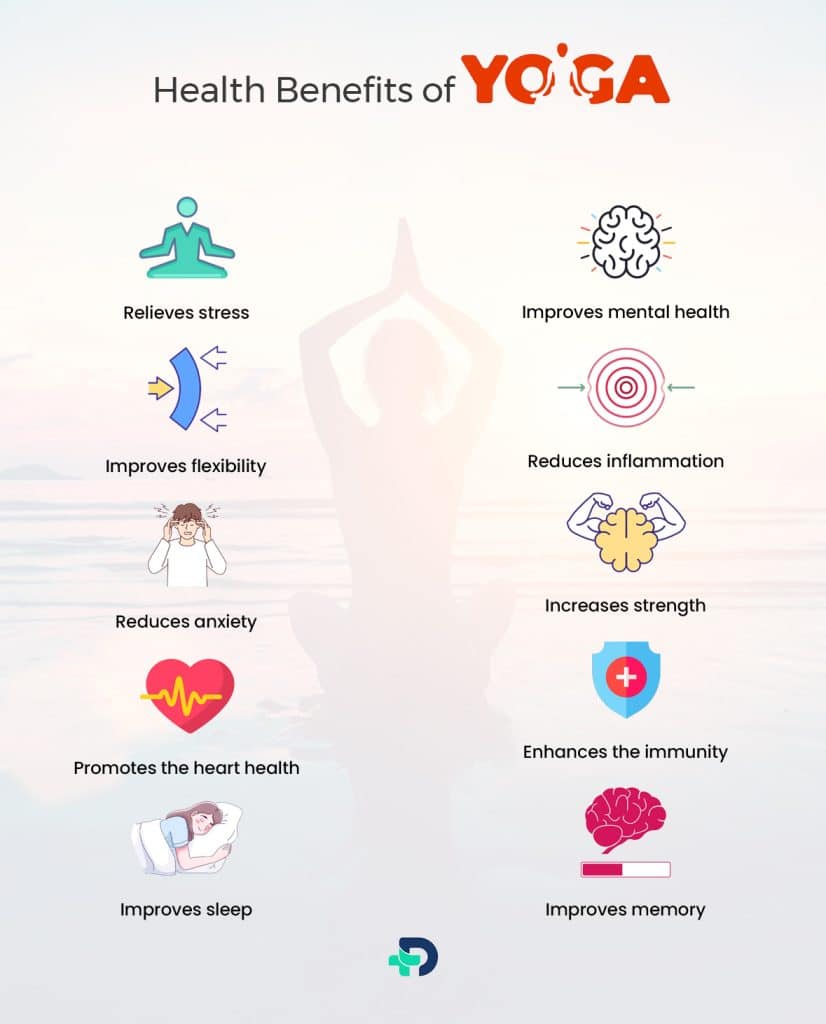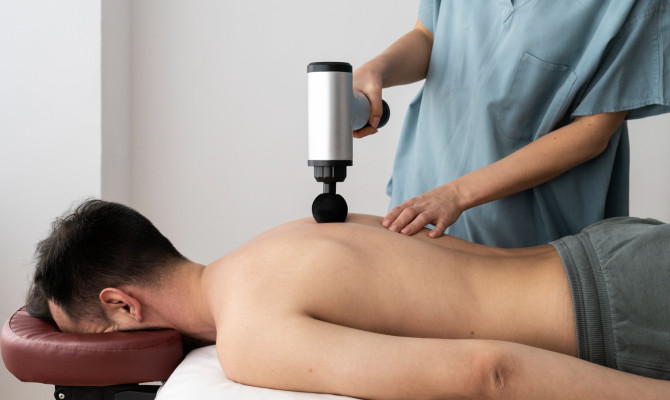Yoga: A Novel Approach to Healthy Living

- Yoga
- 22 Aug 2023
Overview
What is Yoga?
Yoga is a conscious body move involving breathing approaches, meditation, and stretching postures. Yoga helps control our stress and pain and enhances our psychological and physical well-being.
Daily Yoga improves an individual’s strength, patience, and overall body flexibility. Yoga has gained popularity all around the globe. In the United States, one in seven individuals practices Yoga for overall well-being1Overview| Researched based study from Nccih.nih.gov Several types of Yoga have multiple benefits. The article delves into how Yoga works in our body, its types, health benefits, risk, and also tips to consider before starting Yoga.

How does Yoga work?
- The physical pose of Yoga reduces anxiety and pain, alleviate the body’s stress level and increase flexibility.
- Yoga helps clear physical obstruction, thereby discharging unexpressed emotions and stress. It also helps release the feel-good hormones viz; endorphins that enormously impact managing stress.
- Concentrating on the Yoga poses increases the mind’s concentration levels, enhancing attentiveness.
- During Yoga, an individual becomes aware of the body’s sensations, mindset, and opinion, making it easy to release life’s negative and neutral experiences. He might also find it easy to acquire happiness, affection, and calmness 2Overview| Researched based study from Sciencedirect.com
Branches
Branches of Yoga
Yoga has different branches that focus on diverse features
The six branches of Yoga are as follows:
Raja yoga
- Raja yoga, or eight-limb Yoga, involves only mind exercise without physical moves. It improves concentration and removes the disturbance of the mind to such an extent that there is only one thought.
Hatha yoga
- Hatha Yoga involves both physical moves and breathing exercises to set the balance of mind and body.
Bhakti yoga
- It establishes spiritual feelings in everything to improve tolerance and acceptance in life. It is an optimistic way to relieve life’s emotions.
Karma yoga
- It is selfless service to others to build a future free from self-centeredness and hopelessness.
Tantra yoga
- It is the Yoga of realization and associates many meditative practices to deepen self-understanding and encourage self-acceptance.
Jnana yoga
- It is the yoga practice for knowing the self in depth. It helps in self-improvement 3Branches| Researched based study from Sciencedirect.com
The Chakras
Chakras of Yoga
The term chakra means circle or wheel. One can think of chakra as the seven different body points where the energy remains concentrated.
When the energy gets obstructed in one chakra, there is a physical and mental imbalance in one’s life, such as tiredness, anxiety, and appetite loss.
Here are the seven different chakras of Yoga, each with its targets:
Ajna
- Ajna is the intuition center located between our eyebrows. It is the third eye chakra.
Vishuddha
- It has a direct relationship with speech and the body’s immune response. It is the throat chakra.
Sahasrara
- It is at the crown of our head. It is responsible for spirituality. It impacts our relationships, personal and professional.
Anahata
- Anahata is at the central part of the chest, and any instability in the chakra impacts our body’s oxygen and hormone levels.
Muladhara
- It is the root chakra at the bottom of our spine and links the mind to the body.
Manipura
- It is the solar plexus chakra situated in the abdominal area. It impacts our self-assurance, self-control, and knowledge.
Svadhishthana
- It is the sacral chakra located in the naval point. It influences our happiness, strength, and comfort4Chakras| Researched based study from Nlm.nih.gov
Types
Types of Yoga
There are numerous types of Yoga. An individual should decide their kind based on their objective and physical strength.
Some of the common types are as follows:
Bikram yoga(Hot yoga)
- People perform hot Yoga in heated rooms of around 105 degrees Fahrenheit. It comprises two breathing exercises and twenty-six postures.
Ashtanga yoga
- It is the ancient type of Yoga that gained popularity later in 1970. It has postures that have a link to breathing exercises.
Iyengar Yoga
- This Yoga requires accurate posture in every move and is performed with blankets, chairs, and blocks.
Kripalu yoga
- This Yoga starts with breathing and mild straightening accompanied by a series of postures and final easing.
Hatha yoga
- It is the primary form of any Yoga and teaches the fundamental physical poses.
Power Yoga
- It is Yoga for building strength and tolerance. It is best for burning the body’s calories.
Kundalini yoga
- It is Yoga that comprises singing followed by breathing techniques and recurrent poses. It activates the energy within the body.
Viniyoga
- It is a type of Yoga that includes breathing approaches and meditation. It is performed according to individual needs.
Sivananda
- It includes twelve poses and a bit of everything like a backbend, forward bend, balances, twist, etc.
Yin yoga
- It involves holding postures for extended durations. It works profoundly and targets the most profound tissue in the body.
Restorative Yoga
- It is a yoga that involves relaxing techniques and requires no physical stress to maintain the pose.
Prenatal Yoga
- It involves techniques and positions specific to pregnant women. It gives support during pregnancy and enables one to get back body figures after childbirth 17Types| Researched based study from Nlm.nih.gov
Health Benefits

Health Benefits of Yoga
Yoga has the following health benefits:
- Relieves stress
- Improves mental health
- Improves flexibility
- Reduces inflammation
- Reduces anxiety
- Increases strength
- Enhances the immunity
- Promotes the heart health
- Improves sleep
- Strengthen the bones
- Improves memory
- Promotes good body posture
Relieves stress
- Science supports yoga asanas (physical posture during hatha yoga) for reducing stress.
- Meditation, singing, and breathing practices also support lessening life tensions 6Health benefits| Researched based study from Nlm.nih.gov
Improves mental health
- Yoga proved an alternative remedy for major depressive disorder
- Yoga poses, along with breathing techniques, proved helpful in relieving depression 7Health benefits| Researched based study from Nlm.nih.gov
Improves flexibility
- Flexibility plays an indispensable role in maintaining overall health
- Researchers have found that even Yoga’s lowest-intensity exercises have considerable flexibility.
- Studies have found that Yoga enhances flexibility in older people over 65 years 8Health benefits| Researched based study from Nlm.nih.gov
Reduces inflammation
- Research has found that different styles of Yoga reduced the pain and swelling associated with persistent conditions such as diabetes and heart diseases 9Health benefits| Researched based study from Nlm.nih.gov
Reduces anxiety
- Many studies have found that yoga asanas can be a complementary treatment for various anxieties.
- Yoga Nidra or yogic sleep (relaxing method for relieving stress) reduced anxiety symptoms, like nervousness and restlessness 10Health benefits| Researched based study from Nlm.nih.gov
Increases strength
- Studies concluded that Yoga effectively builds strength in people of different ages.
- Yoga has also been found effective in elderly persons and youngsters in maintaining strength 11Health benefits| Researched based study from Nlm.nih.gov
Enhances the immunity
- Research has found a connection between performing Yoga and improved immune response.
- It improves the body’s ability to combat infections 12Health benefits| Researched based study from Nlm.nih.gov
Promotes the heart health
- Review studies have found that Yoga breathing exercises improve the heart rate and control blood pressure.
- It also impacts the brain’s cardiac center 13Health benefits| Researched based study from Nlm.nih.gov
Improves sleep
- Research has found that Yoga improves the sleep quality
- It also makes one fall asleep in no time 14Health benefits| Researched based study from Nlm.nih.gov
Strengthen the bones
- Yoga asanas prevented bone mineral loss in osteoporosis
- It significantly increased the bone ability 15Health benefits| Researched based study from Nlm.nih.gov
Improves memory
- Studies have found that Yoga improves the brain functioning
- It also enhanced concentration and enthusiasm in individuals 16Health benefits| Researched based study from Nlm.nih.gov
Promotes good body posture
- Yoga loosens stiff muscles and improves the body’s mobility
- Regular Yoga can help maintain a better posture 17Health benefits| Researched based study from Nlm.nih.gov
Risk
Risk of Yoga
- Most Yoga is safe when taught by well-trained instructors. Although injuries while performing Yoga is quite rare, the most common ones are body sprains (tearing of the ligaments)
- Pregnant women and people with medical conditions such as asthma, high blood pressure, sciatica pain, or eye problems must consult the doctor before participating in the yoga class.
- One doing Yoga for the first time should avoid complicated postures and deep, forceful breathing.
- Some people might require avoiding certain positions to evade potential injuries.
- People on medical treatment should not substitute Yoga for conventional medical care or postpone doctor’s appointments for pain 18Risk| Researched based study from Sciencedirect.com
Tips
Tips to have safe yoga practice
Tips for Yoga for Beginners
- Enquire the class before time as sometimes beginner class is designed for younger people or people with some experience in Yoga.
- Always talk to the teacher before attending or watch a little of the class before participating.
- Join a slow-going yoga class that gives you time to understand the body
- Always inform the instructor that you are a beginner or about any other medical issues
Tips to consider before Starting Yoga
- Enquire about the requisite experience of your yoga teacher that you are bearing in mind.
- Avoid postponing medical health checkups to perform Yoga
- Consult with the doctor about the health approaches that you are taking, including Yoga, to make informed decisions
Takeaway
Key Takeaways
- Yoga is a fantastic way to regain energy, reduce tension and promote general well-being.
- There are many yoga types, but the ones an individual takes up depend on the goals and physical ability. People with medical issues should take up Yoga slowly and carefully.
- Yoga can help sustain a healthy, active everyday life.
Any feedback on this article?
 This Articles content was accurate
This Articles content was accurate Very Informative Article
Very Informative Article I have a question or a comment
I have a question or a comment
 This article contains inaccurate content
This article contains inaccurate content This article was not helpful
This article was not helpful I have a question or a comment
I have a question or a comment
We appreciate your helpful feedback!
Checkout our social pages
References
-
National Center for Complementary and Integrative Health
Yoga: What You Need To Know | Overview
-
Science Direct
YOGA | Overview
-
Science Direct
'Effects of yoga on brain waves and structural activation: A review | Branches
-
National Library of Medicine
Awakening of Kundalini Chakras Presenting as Psychosis—A Case Report | Chakra
-
National Library of Medicine
Exploring How Different Types of Yoga Change Psychological Resources and Emotional Well-Being across a Single Session | Types
-
National Library of Medicine
Effects of Singing Bowl Sound Meditation on Mood, Tension, and Well-being: An Observational Study | Health Benefits
-
National Library of Medicine
Treatment of Major Depressive Disorder with Iyengar Yoga and Coherent Breathing: A Randomized Controlled Dosing Study | Health Benefits
-
National Library of Medicine
The effects of yoga compared to active and inactive controls on physical function and health related quality of life in older adults- systematic review and meta-analysis of randomised controlled trials' | Health Benefits
-
National Library of Medicine
Chronic Inflammation | Health Benefits
-
National Library of Medicine
The Impact of Yoga Nidra and Seated Meditation on the Mental Health of College Professors | Health Benefits
-
National Library of Medicine
Age related differences of selected Hatha yoga practices on anthropometric characteristics, muscular strength and flexibility of healthy individuals | Health Benefits
-
National Library of Medicine
Yoga and immune system functioning: a systematic review of randomized controlled trials | Health Benefits
-
National Library of Medicine
Role of Yoga in Cardiac Disease and Rehabilitation | Health Benefits
-
National Library of Medicine
Interrelationship between Sleep and Exercise: A Systematic Review | Health Benefits
-
National Library of Medicine
Twelve-Minute Daily Yoga Regimen Reverses Osteoporotic Bone Loss | Health Benefits
-
National Library of Medicine
What Has Neuroimaging Taught Us on the Neurobiology of Yoga? A Review | Health Benefits
-
National Library of Medicine
'Effects of yoga on cardiovascular disease risk factors: A systematic review and meta-analysis | Health Benefits
-
Science Direct
Injury in yoga asana practice: Assessment of the risks | Risk




































